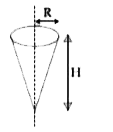Distance of the centre of mass of a solid uniform cone from its vertex is z0. It the radius of its base is R and its height is h then z0 is equal to:
3h4
5h8
3h28R
h24R
The correct Answer is:A
To find the distance of the center of mass of a solid uniform cone from its vertex, we can follow these steps:
Step 1: Understand the Geometry of the Cone
We have a solid uniform cone with a height h and a base radius R. The center of mass will lie along the axis of symmetry of the cone.
Step 2: Set Up the Elemental Volume
Consider a thin disk of thickness dy at a distance y from the vertex of the cone. The radius of this disk, denoted as r, can be determined using similar triangles.
Step 3: Relate the Radius of the Disk to the Height
From the geometry of the cone, we can establish the relationship:
ry=Rh⟹r=Rhy
Step 4: Calculate the Volume of the Disk
The volume dV of the thin disk is given by:
dV=πr2dy=π(Rhy)2dy=πR2h2y2dy
Step 5: Calculate the Mass of the Disk
Assuming the density of the cone is ρ, the mass dm of the disk is:
dm=ρdV=ρπR2h2y2dy
Step 6: Find the Center of Mass Contribution
The y-coordinate of the center of mass of the disk is simply y. Therefore, the contribution to the center of mass d(ycm) from this disk is:
d(ycm)=y⋅dm=y⋅(ρπR2h2y2dy)
Step 7: Integrate to Find the Total Center of Mass
The total center of mass ycm of the cone is given by:
ycm=∫h0y⋅dm∫h0dm
We need to compute both the numerator and the denominator.
Numerator:
∫h0y⋅dm=∫h0y⋅(ρπR2h2y2dy)=ρπR2h2∫h0y3dy=ρπR2h2⋅h44=ρπR2h44h2=ρπR2h24
Denominator:
∫h0dm=∫h0ρπR2h2y2dy=ρπR2h2⋅h33=ρπR2h3
Step 8: Combine Results to Find ycm
Now substituting back into the formula for ycm:
ycm=ρπR2h24ρπR2h3=3h4
Conclusion
Thus, the distance of the center of mass of the solid uniform cone from its vertex is:
z0=3h4
We have a solid uniform cone with a height h and a base radius R. The center of mass will lie along the axis of symmetry of the cone.
Consider a thin disk of thickness dy at a distance y from the vertex of the cone. The radius of this disk, denoted as r, can be determined using similar triangles.
From the geometry of the cone, we can establish the relationship:
ry=Rh⟹r=Rhy
The volume dV of the thin disk is given by:
dV=πr2dy=π(Rhy)2dy=πR2h2y2dy
Assuming the density of the cone is ρ, the mass dm of the disk is:
dm=ρdV=ρπR2h2y2dy
The y-coordinate of the center of mass of the disk is simply y. Therefore, the contribution to the center of mass d(ycm) from this disk is:
d(ycm)=y⋅dm=y⋅(ρπR2h2y2dy)
The total center of mass ycm of the cone is given by:
ycm=∫h0y⋅dm∫h0dm
We need to compute both the numerator and the denominator.
∫h0y⋅dm=∫h0y⋅(ρπR2h2y2dy)=ρπR2h2∫h0y3dy=ρπR2h2⋅h44=ρπR2h44h2=ρπR2h24
∫h0dm=∫h0ρπR2h2y2dy=ρπR2h2⋅h33=ρπR2h3
Now substituting back into the formula for ycm:
ycm=ρπR2h24ρπR2h3=3h4
Thus, the distance of the center of mass of the solid uniform cone from its vertex is:
z0=3h4
Topper's Solved these Questions
Similar Questions
Knowledge Check
- Question 1 - Select One
The centre of gravity of a hollow cone of height h is at distance x from its vertex where the value of x is:
Ah/3Bh/4C2h/3D3h/4
Find the total surface area of a cone, if its slant height is 9m and the radius of its base is 12m.
View SolutionFind the curved surface area of a cone, if its slant height is 60cm and the radius of its base is 21cm.
View SolutionThe curved surface area of a cone is 12320cm2. If the radius of its base is 56 cm, find its height.
View SolutionThe height of a cone is 15cm. If its volume is 500π cm3 , then find the radius of its base.
View SolutionThe height of a cone is 7 cm and its radius of base is 3 cm. Find its volume.
View SolutionShown in the figure is a hollow ice-cream cone (it is open at the top). If its mass is M, radius of its top , R and height , H, then its moment of inertia its axis is :
 View Solution
View SolutionThe vertical height of a right circular cone is 9 cm and radius of its base is 4 cm. Find its volume.
View Solution

